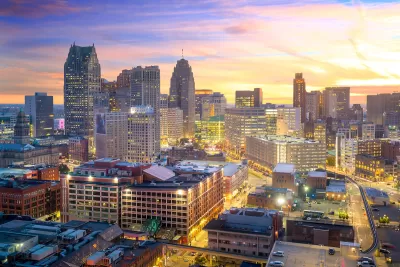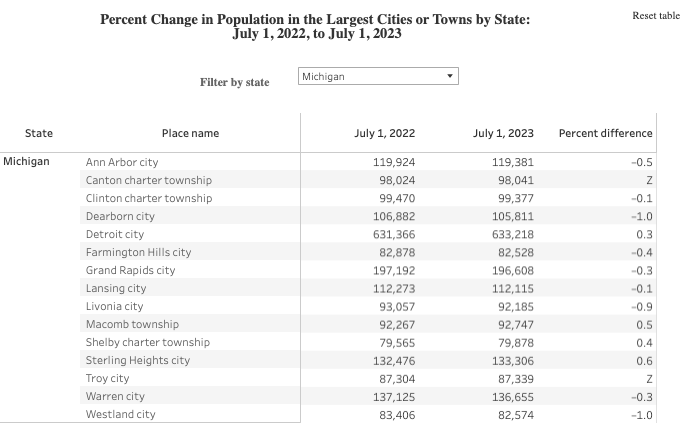It's been 66 years since the Motor City last grew its population. Census data released last month revealed an increase of nearly 2,000 people last year, nearly half the state's population growth.

“Outside of New York, Chicago, and Los Angeles, there is perhaps no more quintessentially American city in this country than Detroit, Michigan,” wrote Rafi Schwartz for The Week on May 29.
At the same time, the past half-century has been challenging for Detroit. The city has lost residents every single year for 66 years. It's been such a precipitous decline that between 1950 and 2010, Detroit's population shrank by a staggering 61%, dropping it from fourth to 27th largest city in the nation.
Indeed, Detroit has often been used as the poster child for America's 'shrinking cities.' No longer.
Schwartz's piece is based on population data released by the U.S. Census Bureau on May 16 (posted here on June 3, “The 15 Fastest-Growing Cities in the US”) that was based on growth in cities and towns from July 1, 2022 to July 1, 2023.
Detroit saw an increase of 1,852 people to 633,218, a 0.3 percent increase, second only to Sterling Heights (0.6 percent), Michigan's fourth most populous city, in percentage gain among the state's larger cities, although Macomb Township and Shelby Charter Township showed slightly higher percentage gains.

“The symbolism [of the population increase] was meaningful in a city that had hollowed out, year after year, since the days when more than 1.8 million people lived there,” reported Julie Bosman, the Chicago bureau chief for The New York Times, on May 16.
City leaders have long promised to reverse Detroit’s long decline in residents brought on by the shrinking of the auto industry, flight to the suburbs and municipal bankruptcy.
The new census estimates showed similar, moderate population rebounds for many big cities in the Midwest and Northeast after previous pandemic-era declines.
State data
The Census national map shows no percentage change in Michigan's population, which saw a slight increase in population that was also worth celebrating, reported Hayley Harding for The Detroit News on Dec. 19, 2023.
“You have to celebrate what you can, even when it's not that big of a win,” said Kurt Metzger, a demographer and the director emeritus of Data Driven Detroit [at Wayne State University].
Related in Planetizen:
- Population Losers, December 28, 2023
- Southern States Lead US Population Growth, December 21, 2023
“In total, new Census Bureau numbers indicate that Michigan has 10,037,261 people, allowing it to hold on to its status as the 10th-largest state by population,” added Harding, noting that the state added 3,980 people from July 1, 2022 to July 1, 2023. The percentage gain rounds to zero, shown by a “Z” on the Census tables.
Detroit accounted for 47% of the growth, with much of the rest coming from adjacent Macomb County, part of northern Metro Detroit.
Challenges ahead
Harding noted that the state ranked 35th among states in growth, well ahead of the eight states that lost population last year, but “behind many of its Midwestern counterparts, including North Dakota (34), Iowa (32), South Dakota (29), Nebraska (27), Wisconsin (20), Minnesota (18), Ohio (16) and Indiana (14).”
Harding added that the Wolverine State has a ways to go.
Since 2020, Michigan is doing even worse compared to its fellow states. Nationally, it ranks 46th for growth from 2020 to 2023, behind only New York, California, Illinois, Louisiana and Pennsylvania. Michigan is down more than 40,000 people from where it was on Census Day in April 2020.
In June 2023, Gov. Gretchen Whitmer created a bipartisan task force, the Growing Michigan Together Council, to reverse the population trajectory. A final report was issued last December describing three strategies “to grow our state’s population and economy while protecting our quality of life and cost of living,” the goal of the task force, according to the governor.

Planetizen Federal Action Tracker
A weekly monitor of how Trump’s orders and actions are impacting planners and planning in America.

Congressman Proposes Bill to Rename DC Metro “Trump Train”
The Make Autorail Great Again Act would withhold federal funding to the system until the Washington Metropolitan Area Transit Authority (WMATA), rebrands as the Washington Metropolitan Authority for Greater Access (WMAGA).

The Simple Legislative Tool Transforming Vacant Downtowns
In California, Michigan and Georgia, an easy win is bringing dollars — and delight — back to city centers.

Albuquerque’s Microtransit: A Planner’s Answer to Food Access Gaps
New microtransit vans in Albuquerque aim to close food access gaps by linking low-income areas to grocery stores, cutting travel times by 30 percent and offering planners a scalable model for equity-focused transit.

This City Will Pay You to Meet Your Neighbors
A North Kansas City grant program offers up to $400 for residents to throw neighborhood block parties.

Commentary: Our Silence Will Not Protect Us
Keeping our heads down and our language inoffensive is not the right response to the times we’re in. Solidarity and courage is.
Urban Design for Planners 1: Software Tools
This six-course series explores essential urban design concepts using open source software and equips planners with the tools they need to participate fully in the urban design process.
Planning for Universal Design
Learn the tools for implementing Universal Design in planning regulations.
Smith Gee Studio
City of Charlotte
City of Camden Redevelopment Agency
City of Astoria
Transportation Research & Education Center (TREC) at Portland State University
US High Speed Rail Association
City of Camden Redevelopment Agency
Municipality of Princeton (NJ)





























